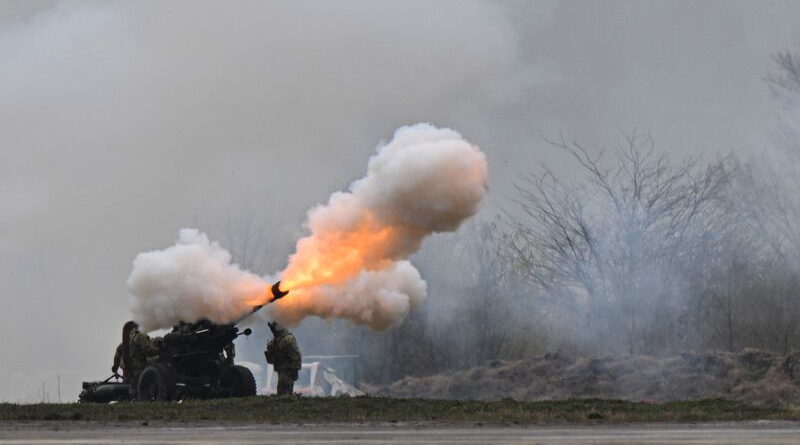Ukraine Is Running Out of Ammo. So Is the US.
America’s industrial base is struggling with supply chains and a shortage of workers while the Pentagon contracts are piling up.
By Fletcher Dean Emeritus James Stavridis, former supreme allied commander of NATO
As the war in Ukraine rages and with Kyiv’s forces likely to begin a major offensive any day now, both sides in the conflict are facing shortages of ammunition, electronic components, precision-guided weapons and even cement. While the West has a vastly larger overall capability to deliver the necessities of combat, snarls in the global commercial supply chain are beginning to manifest.
The real “spring offensive” may not be tanks and armor, but upscaled weapons production in the factories of Ukraine’s democratic supporters. What should they be doing collectively to make sure the Ukrainians get what they need to turn back Russia’s illegal and immoral invasion? And what will be the impact on broader global supply chains?
As the North Atlantic Treaty Organization’s military commander over a decade ago, I would often look deep into logistics and supply chains as I contemplated our combat operations in Afghanistan, the Balkans, Libya and counterpiracy. We felt comfortable that the overall Western defense industrial base — which supports over $1.2 trillion in collective military budgets for the 31 NATO nations — could handle those conflicts with relative ease.
But what made me nervous a decade ago was the possibility of great power conflict in Europe — notably a potential flare-up with the Russian federation. While the democratic allies enjoy an overwhelming capability and inventory advantage (Russia’s total defense budget is under $70 billion, one-tenth of NATO’s at best), the Russians have a competent industrial base, lots of raw materials, and can draw on conscript labor to man the machines in their foundries and factories.
While NATO is more than a year out of Afghanistan, the huge needs of Ukraine are driving challenges in supplying material to combat operations at a level I did not anticipate. The need for electronic components in particular — to build precision-guided weapons, sophisticated drones, anti-ship cruise missiles, and so-called smart artillery rounds — is soaring. Despite the sluggish global economy, civilian firms are competing with the Western militaries for the crucial semi-conductor chips, particularly the high-end ones produced largely in Taiwan.
Western car manufacturers and heavy equipment producers, from Caterpillar Inc. to General Motors Co., are feeling the pinch. Cement, in high demand in the US for the infrastructure projects just beginning to come online from the Bipartisan Infrastructure Law, is getting scarce as Ukrainian war needs rise for reconstruction.
A number of analyses and war simulations are trying to project where the critical pain points will occur. Guns, missiles and ammunition — especially howitzer shells — are of most concern. Notable among the stockpiles running low are the 155-mm gun rounds that have emerged as the key offensive punch for the Ukrainians. Several analysts believe that Ukraine is burning through a year’s worth of US prewar production monthly.
While the Department of Defense will continue to protect its own war reserves, the excess armament levels — stockpiled for contingencies beyond basic needs of the US war plans — are very low. And it is not just howitzer rounds: The high-performance HIMARS rockets are in short supply as well, for example.
The defense industrial base is stepping up production, taking a page out of the US industrial complex at the start of World War II. As the Yale Historian Paul Kennedy outlines in his brilliant book, “Engineers of Victory,” about the technology, organization, and war production that turned the tide in the war, the allies eventually outproduced the axis.
While we are far from the total mobilization of the early 1940s, both the big defense primes and many smaller producers of high-tech systems (notably drones) are rapidly innovating and producing what the Ukrainians will need in the months ahead. But as new orders have increased, another problem has emerged: a severe shortage of skilled munitions workers.
When President Franklin D. Roosevelt gave his memorable “arsenal of democracy speech” in 1940, the US economy was about to move to a full war footing. Clearly, we are not going to do that today. So, the challenge will be to continue to produce both guns and butter in the face of Russian aggression.
Congress and the Pentagon have the tools to do so, primarily money. US military support to Ukraine is significant (over $40 billion) but only a small fraction of the $850 billion defense budget. America’s European partners (and Asian allies like Japan and South Korea) will be providing nearly equal amounts of assistance, although their support will be focused more on humanitarian needs and economic reconstruction.
Both sides of the Atlantic will be providing selected combat systems (especially tanks and ground armor) and artillery rounds. Governments in the West will have to guarantee the contractual production, so the defense firms are not left holding the bag if the war abruptly concludes (which does not, admittedly, appear to be on the horizon).
While there will be some pinching in specific global commercial supply chains (e.g., electronics, construction materials, some minerals), the overall capacity to outproduce the tottering Russian economy is clear. Assuming China continues to wisely decline to throw Putin a war material lifeline, Russia will fall further and further behind Western production abilities. This classic “American way of war,” which succeeded in both World War II and ultimately in the Cold War, keeps the odds in favor of the Ukrainians.
(This post is republished from Bloomberg Opinion.)

